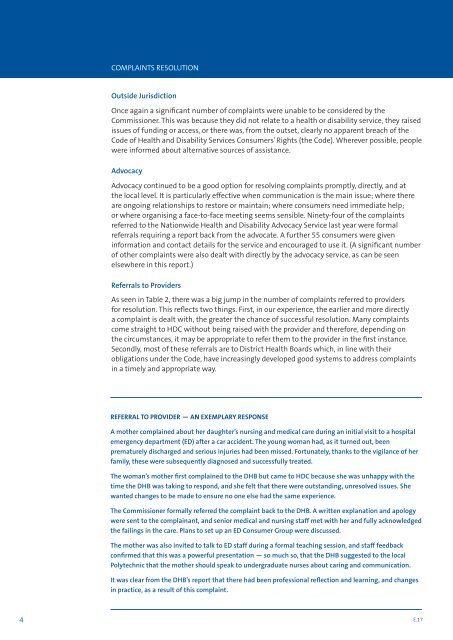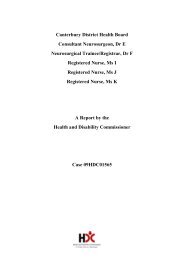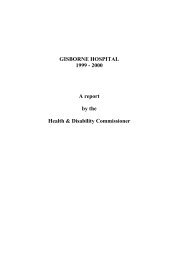Annual Report for the year ended 30 June 2009 - Health and ...
Annual Report for the year ended 30 June 2009 - Health and ...
Annual Report for the year ended 30 June 2009 - Health and ...
Create successful ePaper yourself
Turn your PDF publications into a flip-book with our unique Google optimized e-Paper software.
COMPLAINTS RESOLUTION<br />
Outside Jurisdiction<br />
Once again a significant number of complaints were unable to be considered by <strong>the</strong><br />
Commissioner. This was because <strong>the</strong>y did not relate to a health or disability service, <strong>the</strong>y raised<br />
issues of funding or access, or <strong>the</strong>re was, from <strong>the</strong> outset, clearly no apparent breach of <strong>the</strong><br />
Code of <strong>Health</strong> <strong>and</strong> Disability Services Consumers’ Rights (<strong>the</strong> Code). Wherever possible, people<br />
were in<strong>for</strong>med about alternative sources of assistance.<br />
Advocacy<br />
Advocacy continued to be a good option <strong>for</strong> resolving complaints promptly, directly, <strong>and</strong> at<br />
<strong>the</strong> local level. It is particularly effective when communication is <strong>the</strong> main issue; where <strong>the</strong>re<br />
are ongoing relationships to restore or maintain; where consumers need immediate help;<br />
or where organising a face-to-face meeting seems sensible. Ninety-four of <strong>the</strong> complaints<br />
referred to <strong>the</strong> Nationwide <strong>Health</strong> <strong>and</strong> Disability Advocacy Service last <strong>year</strong> were <strong>for</strong>mal<br />
referrals requiring a report back from <strong>the</strong> advocate. A fur<strong>the</strong>r 55 consumers were given<br />
in<strong>for</strong>mation <strong>and</strong> contact details <strong>for</strong> <strong>the</strong> service <strong>and</strong> encouraged to use it. (A significant number<br />
of o<strong>the</strong>r complaints were also dealt with directly by <strong>the</strong> advocacy service, as can be seen<br />
elsewhere in this report.)<br />
Referrals to Providers<br />
As seen in Table 2, <strong>the</strong>re was a big jump in <strong>the</strong> number of complaints referred to providers<br />
<strong>for</strong> resolution. This reflects two things. First, in our experience, <strong>the</strong> earlier <strong>and</strong> more directly<br />
a complaint is dealt with, <strong>the</strong> greater <strong>the</strong> chance of successful resolution. Many complaints<br />
come straight to HDC without being raised with <strong>the</strong> provider <strong>and</strong> <strong>the</strong>re<strong>for</strong>e, depending on<br />
<strong>the</strong> circumstances, it may be appropriate to refer <strong>the</strong>m to <strong>the</strong> provider in <strong>the</strong> first instance.<br />
Secondly, most of <strong>the</strong>se referrals are to District <strong>Health</strong> Boards which, in line with <strong>the</strong>ir<br />
obligations under <strong>the</strong> Code, have increasingly developed good systems to address complaints<br />
in a timely <strong>and</strong> appropriate way.<br />
REFERRAL TO PROVIDER — AN EXEMPLARY RESPONSE<br />
A mo<strong>the</strong>r complained about her daughter’s nursing <strong>and</strong> medical care during an initial visit to a hospital<br />
emergency department (ED) after a car accident. The young woman had, as it turned out, been<br />
prematurely discharged <strong>and</strong> serious injuries had been missed. Fortunately, thanks to <strong>the</strong> vigilance of her<br />
family, <strong>the</strong>se were subsequently diagnosed <strong>and</strong> successfully treated.<br />
The woman’s mo<strong>the</strong>r first complained to <strong>the</strong> DHB but came to HDC because she was unhappy with <strong>the</strong><br />
time <strong>the</strong> DHB was taking to respond, <strong>and</strong> she felt that <strong>the</strong>re were outst<strong>and</strong>ing, unresolved issues. She<br />
wanted changes to be made to ensure no one else had <strong>the</strong> same experience.<br />
The Commissioner <strong>for</strong>mally referred <strong>the</strong> complaint back to <strong>the</strong> DHB. A written explanation <strong>and</strong> apology<br />
were sent to <strong>the</strong> complainant, <strong>and</strong> senior medical <strong>and</strong> nursing staff met with her <strong>and</strong> fully acknowledged<br />
<strong>the</strong> failings in <strong>the</strong> care. Plans to set up an ED Consumer Group were discussed.<br />
The mo<strong>the</strong>r was also invited to talk to ED staff during a <strong>for</strong>mal teaching session, <strong>and</strong> staff feedback<br />
confirmed that this was a powerful presentation — so much so, that <strong>the</strong> DHB suggested to <strong>the</strong> local<br />
Polytechnic that <strong>the</strong> mo<strong>the</strong>r should speak to undergraduate nurses about caring <strong>and</strong> communication.<br />
It was clear from <strong>the</strong> DHB’s report that <strong>the</strong>re had been professional reflection <strong>and</strong> learning, <strong>and</strong> changes<br />
in practice, as a result of this complaint.<br />
4 E.17

















